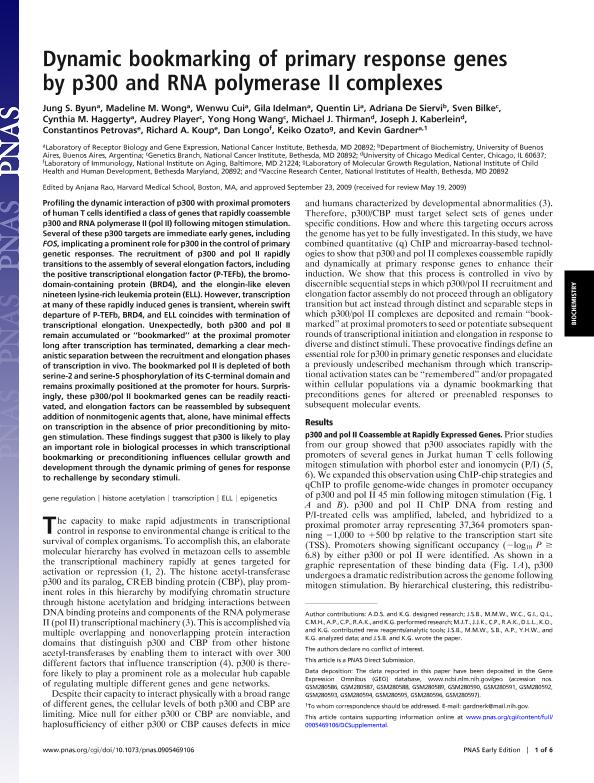Mostrar el registro sencillo del ítem
dc.contributor.author
Byun, Jung S.

dc.contributor.author
Wong, Madeline M.
dc.contributor.author
Cui, Wenwu
dc.contributor.author
Idelman, Gila
dc.contributor.author
Li, Quentin
dc.contributor.author
de Siervi, Adriana

dc.contributor.author
Bilke, Sven
dc.contributor.author
Haggerty, Cynthia M.

dc.contributor.author
Player, Audrey
dc.contributor.author
Wang, Yong Hong
dc.contributor.author
Thirman, Michael J.
dc.contributor.author
Kaberlein, Joseph J.
dc.contributor.author
Petrovas, Constantinos
dc.contributor.author
Koup, Richard A.
dc.contributor.author
Longo, Dan L.

dc.contributor.author
Ozato, Keiko
dc.contributor.author
Gardner, Kevin

dc.date.available
2019-09-19T21:54:32Z
dc.date.issued
2009-11
dc.identifier.citation
Byun, Jung S.; Wong, Madeline M.; Cui, Wenwu; Idelman, Gila; Li, Quentin; et al.; Dynamic bookmarking of primary response genes by p300 and RNA polymerase II complexes; National Academy of Sciences; Proceedings of the National Academy of Sciences of The United States of America; 106; 46; 11-2009; 19286-19291
dc.identifier.issn
0027-8424
dc.identifier.uri
http://hdl.handle.net/11336/83950
dc.description.abstract
Profiling the dynamic interaction of p300 with proximal promoters of human T cells identified a class of genes that rapidly coassemble p300 and RNA polymerase II (pol II) following mitogen stimulation. Several of these p300 targets are immediate early genes, including FOS, implicating a prominent role for p300 in the control of primary genetic responses. The recruitment of p300 and pol II rapidly transitions to the assembly of several elongation factors, including the positive transcriptional elongation factor (P-TEFb), the bromodomain-containing protein (BRD4), and the elongin-like eleven nineteen lysine-rich leukemia protein (ELL). However, transcription at many of these rapidly induced genes is transient, wherein swift departure of P-TEFb, BRD4, and ELL coincides with termination of transcriptional elongation. Unexpectedly, both p300 and pol II remain accumulated or "bookmarked" at the proximal promoter long after transcription has terminated, demarking a clear mechanistic separation between the recruitment and elongation phases of transcription in vivo. The bookmarked pol II is depleted of both serine-2 and serine-5 phosphorylation of its C-terminal domain and remains proximally positioned at the promoter for hours. Surprisingly, these p300/pol II bookmarked genes can be readily reactivated, and elongation factors can be reassembled by subsequent addition of nonmitogenic agents that, alone, have minimal effects on transcription in the absence of prior preconditioning by mitogen stimulation. These findings suggest that p300 is likely to play an important role in biological processes in which transcriptional bookmarking or preconditioning influences cellular growth and development through the dynamic priming of genes for response to rechallenge by secondary stimuli.
dc.format
application/pdf
dc.language.iso
eng
dc.publisher
National Academy of Sciences

dc.rights
info:eu-repo/semantics/openAccess
dc.rights.uri
https://creativecommons.org/licenses/by-nc-sa/2.5/ar/
dc.subject
Ell
dc.subject
Epigenetics
dc.subject
Gene Regulation
dc.subject
Histone Acetylation
dc.subject
Transcription
dc.subject.classification
Bioquímica y Biología Molecular

dc.subject.classification
Ciencias Biológicas

dc.subject.classification
CIENCIAS NATURALES Y EXACTAS

dc.title
Dynamic bookmarking of primary response genes by p300 and RNA polymerase II complexes
dc.type
info:eu-repo/semantics/article
dc.type
info:ar-repo/semantics/artículo
dc.type
info:eu-repo/semantics/publishedVersion
dc.date.updated
2019-01-02T19:12:46Z
dc.journal.volume
106
dc.journal.number
46
dc.journal.pagination
19286-19291
dc.journal.pais
Estados Unidos

dc.journal.ciudad
Washington
dc.description.fil
Fil: Byun, Jung S.. National Cancer Institute; Estados Unidos
dc.description.fil
Fil: Wong, Madeline M.. National Cancer Institute; Estados Unidos
dc.description.fil
Fil: Cui, Wenwu. National Cancer Institute; Estados Unidos
dc.description.fil
Fil: Idelman, Gila. National Cancer Institute; Estados Unidos
dc.description.fil
Fil: Li, Quentin. National Cancer Institute; Estados Unidos
dc.description.fil
Fil: de Siervi, Adriana. Consejo Nacional de Investigaciones Científicas y Técnicas. Oficina de Coordinación Administrativa Ciudad Universitaria. Instituto de Química Biológica de la Facultad de Ciencias Exactas y Naturales. Universidad de Buenos Aires. Facultad de Ciencias Exactas y Naturales. Instituto de Química Biológica de la Facultad de Ciencias Exactas y Naturales; Argentina
dc.description.fil
Fil: Bilke, Sven. National Cancer Institute; Estados Unidos
dc.description.fil
Fil: Haggerty, Cynthia M.. National Cancer Institute; Estados Unidos
dc.description.fil
Fil: Player, Audrey. National Cancer Institute; Estados Unidos
dc.description.fil
Fil: Wang, Yong Hong. National Cancer Institute; Estados Unidos
dc.description.fil
Fil: Thirman, Michael J.. The University Of Chicago Medicine; Estados Unidos
dc.description.fil
Fil: Kaberlein, Joseph J.. The University Of Chicago Medicine; Estados Unidos
dc.description.fil
Fil: Petrovas, Constantinos. National Institutes of Health; Estados Unidos
dc.description.fil
Fil: Koup, Richard A.. National Institutes of Health; Estados Unidos
dc.description.fil
Fil: Longo, Dan L.. National Institute On Aging; Estados Unidos
dc.description.fil
Fil: Ozato, Keiko. National Instituto of Child Health & Human Development; Estados Unidos
dc.description.fil
Fil: Gardner, Kevin. National Cancer Institute; Estados Unidos
dc.journal.title
Proceedings of the National Academy of Sciences of The United States of America

dc.relation.alternativeid
info:eu-repo/semantics/altIdentifier/doi/https://doi.org/10.1073/pnas.0905469106
dc.relation.alternativeid
info:eu-repo/semantics/altIdentifier/url/https://www.pnas.org/content/106/46/19286
Archivos asociados
